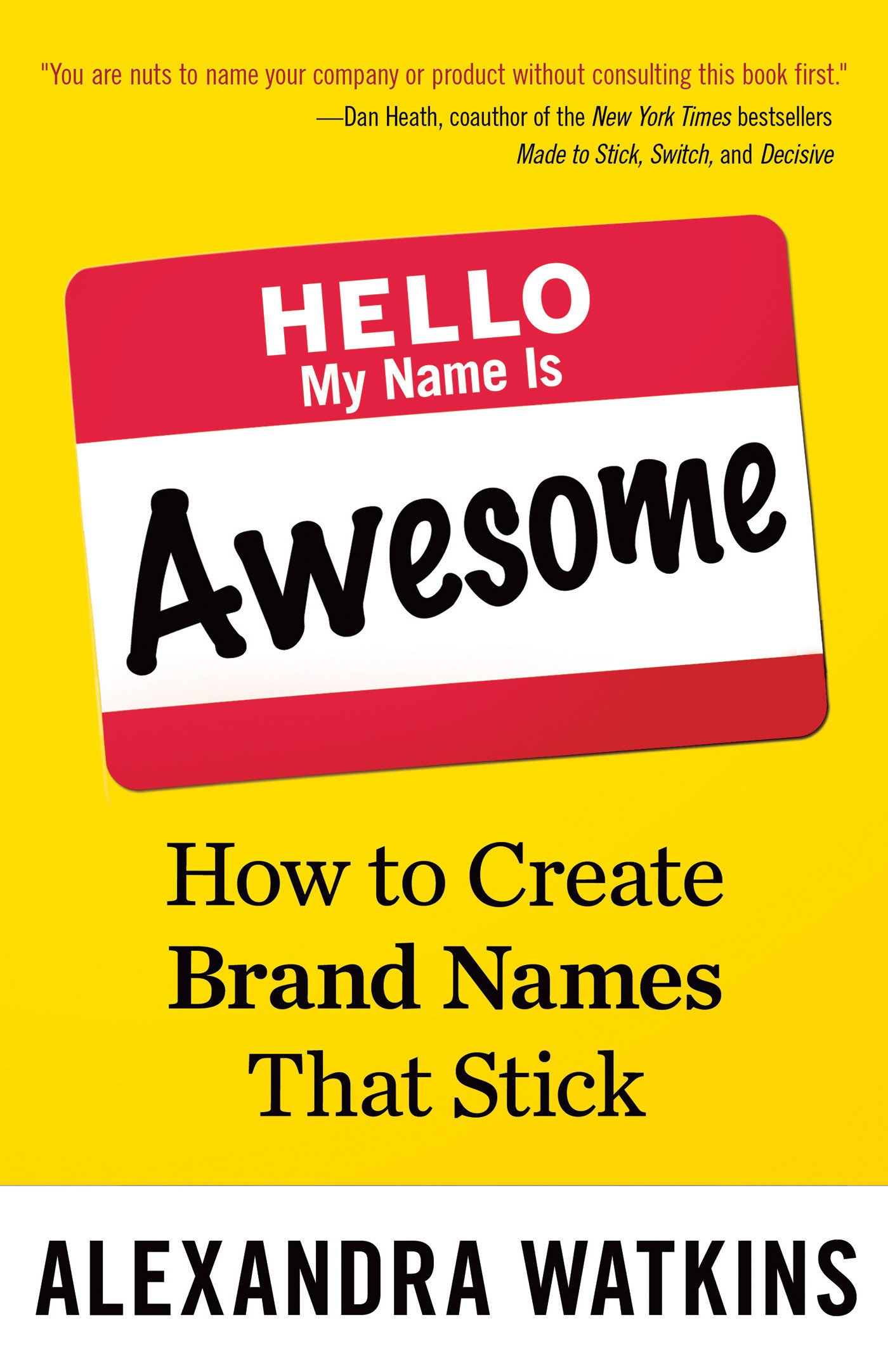
AN EXECUTIVE SUMMARY OF
HOW TO CREATE BRAND NAMES THAT STICK
by Alexandra Watkins
Who is Alexandra Watkins?
Alexandra Watkins is a brand name expert and founded the agency Eat My Words in 2005. The agency has worked with a lot of prominent companies, just check out their website.
My General Thoughts on the Book
This is one of the best product naming books I have read. Generally I read naming books with an eye for what I disagree with, but it was hard with this book because I agree with the overwhelming majority of it. The book is a short and easy read. If you can’t afford to hire a naming expert, this is a must read and is worth every penny.
Chapter 1: The 5 Qualities of a Super-Sticky Name
A central premise of this book is the SMILE & SCRATCH name evaluation test based on “a name should make you smile instead of scratch your head.” I am not convinced that a name that makes you scratch your head is necessarily a bad thing and will discuss that further in my thoughts on Chapter 2. SMILE is an acronym for the 5 qualities of a great name, while SCRATCH is an acronym for the 7 deal breakers.
The book identifies the 5 qualities of a super-sticky name as: Suggestive, Meaningful, Imagery, Legs, and Emotional, hence the SMILE acronym. The book provides a nice concise explanation of each of these 5 qualities and sprinkles in real-world examples.
With respect to the “Suggestive” quality, a key point that I whole-heartedly agree with is:
“A name can’t be expected to say everything, but it should suggest something about your brand. Not in a descriptive way, like Fast Signs, but in a creative or metaphorical way, such as Amazon.”
Alexandra goes on to discuss suggestive coined names and lists her favorite examples as “Dreamery, Groupon, Pictionary, Cinnabon, Chillow, Pinterest, Chuggernaut, and San Franpsycho,” which “work well because they cleverly marry two words together, are intuitive to spell, and easy to pronounce.”
Since virtually every company developing a new name expresses the desire that the name suggests trust and credibility, “trying to cram any form of those words into your name can sound disingenuous.” Yes, yes, yes… I couldn’t agree more. Alexandra points out that “actions speak louder than words.”
With respect to the “Meaningful” quality, the book makes the great point that “a meaningful long name is better than a short meaningless name.” As for the “Imagery” quality, a product name should be “visually evocative to aid in memory” and Alexandra makes the point that “when people can visualize your name with a picture, it’s much easier for them to remember than an unfamiliar word or acronym that doesn’t give their mind anything to latch on to.” This is an excellent point, and the book provides many great examples.
Unlike most naming books, the “Legs” quality of the SMILE acronym highlights that a name should provide “a theme with mileage you can build a brand around,” and “names with legs provide endless wordplay and verbal branding opportunities.” This can be golden for some products/services; however it is not essential for all. Additionally, having “Legs” is extremely difficult to accomplish, particularly without being, as Alexandra points out, “cutesy, corney, or over the top.” Once again, the book provides many great examples. Lastly, with respect to the “Emotional” quality, the book references an article citing “that 50 percent of every buying decision is driven by emotion,” and points out that emotion increases sales.
There you have it; the first chapter is strong enough alone to warrant reading this book.
Chapter 2: The 7 Deadly Sins
As previously mentioned, SCRATCH is an acronym for the 7 deal breakers, which equates to: Spelling challenged, Copycat, Restrictive, Annoying, Tame, Curse of Knowledge, and Hard to pronounce. The chapter goes into detail on each of these deal breakers, many of which may make the reader think “duh, that is common sense,” but the reality is that those new to naming often feel like they are doing something clever while committing one, or more, of these deal breakers.
A great point made in this chapter is to think about voice recognition, what Alexandra calls the “Siri theory.” Think about how your smart device (phone, car, Echo, etc.) would respond to you when verbally asking it for the phone number, address, or product cost. I feel one of the most overlooked aspects of naming is the deadly sin of being “Tame,” which the book describes as “flat, descriptive, uninspired.” Alexandra makes the point “if you want your name to stand out in a sea of sameness and get noticed – without a massive advertising budget – you can’t afford to be shy.”
Other valuable nuggets of wisdom in this chapter include (a) always check proposed names against entries in Urban Dictionary to ensure it does not have an undesirable slang definition, and (b) avoid names that are hard to pronounce.
The first and second chapters make up the bulk of the book, should take less than 30 minutes to read, and are worth their weight in gold.
Chapter 3: Domain – Strategies, Secrets, and Silliness
I often tell clients that the worst thing they can do when undertaking a new product/service naming project is to start their screening based upon whether a domain name is available. The book echoes this sentiment and provides great strategies and secrets to overcome this common mistake. For example, just consider this website, the domain name wobble.com was already taken but it didn’t cause me to scratch the name off the list of potentials, rather I acquired HobbleTheWobble.com, which is actually better because it provides context to the name and is arguably easier to remember. Sure, I would have liked to been able to acquire wobble.com, but the fact that it wasn’t available was barely even a consideration for me. This chapter does a good job of highlighting that longer domain names are perfectly acceptable.
Chapter 4: Creative Brief – Your Brand Name Road Map
This chapter outlines a “creative brief,” which Alexandra describes as “the ingredients list of everything you need to cook up the perfect name.” A nice sample template is provided and the book highlights why this is an important first step to take, long before the brainstorming begins. Once again, the value of this chapter alone is far greater than the investment you would make in purchasing and reading this book.
Chapter 5: Brainstorming
Brainstorming is an essential part of naming a new product/service, and the process that each person takes is very personal depending on the type of person you are. Nonetheless, this chapter provides nice helpful examples of Alexandra’s process, as well as listing free online brainstorming tools such as IdiomConnection.com, Wordoid.com, RhymeZone.com, Wordnik.com, and Visuwords.com.
Chapter 6: Name Review – 12 Rules for Building Consensus
The unfortunate reality is that when it comes to naming, it is highly likely that multiple individuals within a company will have to “sign-off” on a new name. Each of these people brings their own experiences and biases, and it is likely that some will have had little involvement in the process. Alexandra’s “12 Rules” are a good framework for guiding the process. Some of the best rules include: (a) “have people initially review the list of names independently, as opposed to in a group,” (b) make sure reviewers aren’t focused on “do I like it,” but rather “is it right,” (c) “a name can’t say everything,” (d) “don’t be afraid to be different,” (e) don’t use focus groups, and (f) “don’t fall in love with any one name until after you have conducted trademark clearance screens.”
This last point is nearly impossible. Over my 16 years of practice, I have watched client after client fall in love with a name only to later do the legal work and realize there are dark gray clouds on the horizon, either regarding the protectability of the name (what I think of as the left hand) or from the perspective of clearance, or risk (what I think of as the right hand). Rarely is it ever 100% black or white, but I want my clients to only have the opportunity to fall in love with names that have a high likelihood of protectability and are broad in nature, and a low likelihood of the client receiving a cease and desist letter, or worse finding themselves on the receiving end of a lawsuit. This is what makes the Wobble Naming services totally unique, we try to eliminate the possibility of a client falling in love with a name that is overcast with those dark gray clouds. After all, as I have witnessed first-hand too many times to count, once a client falls in love with a name, they do their best to rationalize why those dark gray clouds aren’t as dark as they appear, and that they probably don’t suggest a thunderstorm (when in fact they do), and that it is highly unlikely to contain lightening (when they generally do). The reality is that clients are about to make a major investment of time and money building a brand around this name, and it is my responsibility to only present them with options that don’t come surrounded by dark gray clouds and minimize the opportunities to rationalize why the likely storm is unlikely. I am in the business of solving problems by ensuring that clients avoid potential problems.
Chapter 7: Name Changes – Pros and Cons
Often times changing the name of a company, a product, or a service, just makes sense and is not as big of a deal as people make it out to be. Companies, products, and services evolve over time, and the current name can be too restrictive and become an anchor on your success. This short chapter identifies some of the pros and cons that should be considered. I often tell clients, if you are talking to me about the possibility of a name change then in your gut you already know the answer to whether you should do it or not.
Resources
By this point it should be pretty clear that I love this book. There are things I do differently and some minor points that I disagree with, but there is no doubt it should be on the shelf of everyone that has anything to do with product naming. Now the “but”… The “resources” section has 3 paragraphs in a section titled “DIY Trademark Searches” and gushes over a free tool known as Trademarkia. As a trademark attorney I know that this is horrible advice that can lead one right into the lightning storm that I previously described. Just do a little online research about this free service and if still aren’t convinced that this is horrible advice, then test out the following scenario. Say you want to name a new shoe product and are considering the names “niky” or even “nikey,” obviously horrible names for a new shoe product. Go to the site and see if provides you with any information to indicate that these are horrible names. DIY trademark searches, or trying to interpret search results without an experienced trademark lawyer, will often lead you right into the heart of a storm. You are about to make a major investment of money and time to build a brand around a new name, don’t be short sighted.
The Take-Away
This is a fabulous book full of great suggestions and examples; buy it and read it once a year. Will it help you create a product name that minimizes the wobble? Absolutely.
I hope you enjoyed this book review. Please join our email list if you would like to be notified when I post additional reviews of product naming books by naming experts; and don’t hesitate to email me (Dave@HobbleTheWobble.com) with suggestions of additional books to review.

